Apple MacBook Air (2012) vs. ASUS Zenbook Prime UX31A
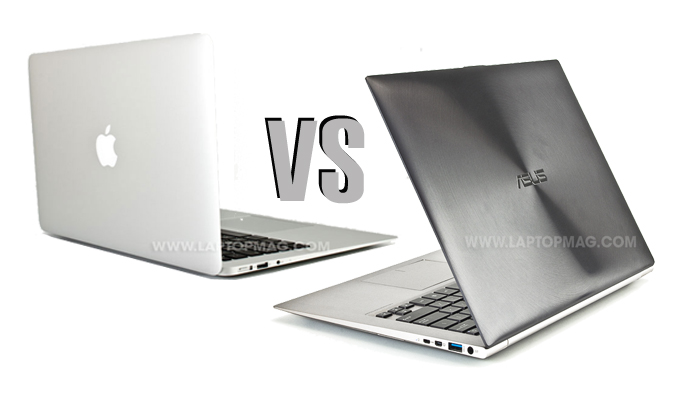
In 2011, Apple’s 13-inch MacBook Air fought the ASUS Zenbook UX31 in a 13-round battle to determine which was the better ultraportable notebook. In that face-off, the Air beat out the UX31, seven rounds to four. A year later, both companies have released successors to their flagship lightweight machines, and ASUS has really improved its Ultrabook. In this face-off, we're pitting the $1,199 Apple MacBook Air against the $1,499 ASUS Zenbook Prime UX31A. Which slim and powerful laptop will reign supreme?
Design
Essentially unchanged since last year for both notebooks, both the Air and the UX31A retain their distinctive wedge shapes, which are both beautiful and functional. The one slight difference is that the UX31A’s lid is now a little bit darker, but still has a neat circular brushed metal pattern. Also, instead of silver keys on a black background, the UX31A now has black keys on a silver background, more Air-like than ever.
WINNER: UX31A. Yes, it copies Apple even more than before, but the Air’s design hasn’t really changed all that much since it was introduced four years ago, and is starting to feel slightly stale.
Ports
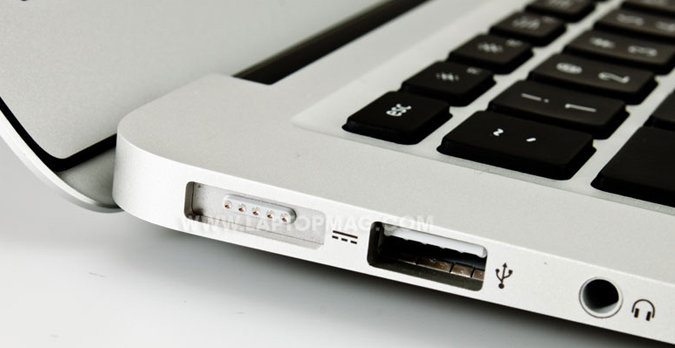
The only real change on the Air is that its two USB ports are now 3.0, as opposed to USB 2.0 from last year. Other than that, it still has a Thunderbolt and an SD card slot on the right, and a thinner Magsafe 2 power jack on the left, along with a headphone/mic port.
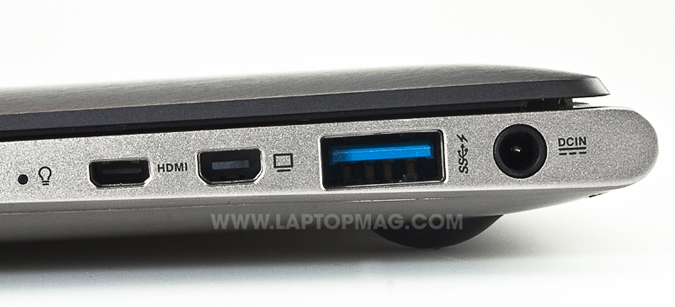
The UX31A also ditched the USB 2.0 port from last year in favor of a USB 3.0 port, bringing its total to two. A microHDMI, a mini VGA, and an SD card slot--the same as last year--round out its selection.
Stay in the know with Laptop Mag
Get our in-depth reviews, helpful tips, great deals, and the biggest news stories delivered to your inbox.
WINNER: ASUS UX31A. While we like that Apple upgraded to USB 3.0, so did Asus, who also includes multiple ways to connect to external monitors. Next year’s version better include Thunderbolt, though.
Keyboard

ASUS made huge strides with the keyboard in the UX31A, as the keys--now plastic instead of metal--are much more comfortable, offer much more travel, and are now backlit. Typing on the UX31A was a pleasurable experience. On the Ten Thumbs Typing Tutor test, we averaged 51 words per minute with a 1 percent error rate.
Apple’s keyboard remains as good as ever. Though we averaged a lower 47 wpm with a 6 percent error rate, the keys themselves felt more comfortable, and were less noisy than the UX31A. Also, there’s less light leakage on the backlighting on the Air than the UX31A.
WINNER: Draw. It’s fair to say that the UX31A’s keyboard is now on a par with the MacBook Air.
Touchpad
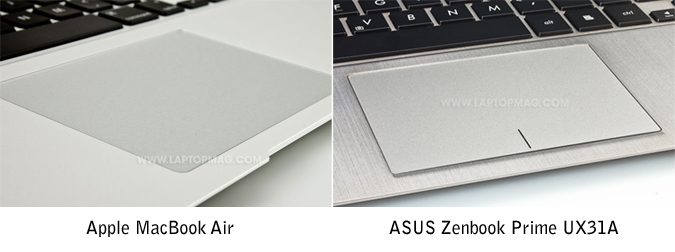
Much credit goes to ASUS for improving the trackpad on the UX31A; it’s miles better than on the previous version, and it’s still a spacious 4.1 x 2.8 inches. Most multitouch gestures worked smoothly, but only after we disabled some settings first. The 4.1 x 3-inch trackpad on the Air hasn’t changed, and that’s a good thing. Multitouch gestures, drag-and-drop were just as smooth and seamless as before.
WINNER: MacBook Air. Though the UX31A's touchpad has improved markedly, we still needed to fiddle with it before it worked the way we wanted. The Air's glass trackpad is still the best in the industry.
Display
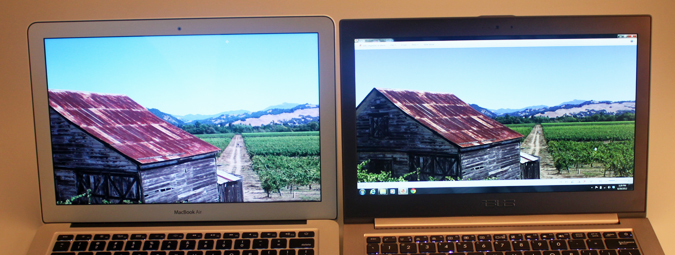
Asus made the biggest strides here, bumping the resolution on the UX31A to 1920 x 1080, up from 1600 x 900 on the UX31. It also increased the average brightness, to 423 lux from 381. By comparison, the Air stayed the same, with a resolution of 1440 x 900, and an average lux of 268 lux.
In a side-by side comparison, we found the UX31A had more saturated colors. For instance, the leaves of a vineyard were a deeper green, and a rusted roof was less reddish than on the Air. Also, owing to its higher resolution, we could see more of the image on the UX31A when blown up to full size. Viewing angles were also slightly better on the UX31, as its screen was less reflective than the Air's.
WINNER: ASUS UX31A. Not only does the Zenbook Prime offer a higher resolution, but it’s far brighter, has more saturated colors, and is less reflective. If Apple had gone with a Retina display, this might have been different, but for now, the Asus Ultrabook has the better screen.
Speakers
Even though they’re hidden under the keyboard, the Air’s speakers make themselves known, in a big way. Whatever we played came through loudly, but accurately as well. The UX31A's speakers, which use Bang & Olufsen's ICEPower technology, also delivered accurate sound, but were much softer. When we played Van Morrison's "Brown Eyed Girl" and Coldplay's "Clocks" on both the Air and the UX31A at their top volume, the Air was more than twice as loud as the UX31A, and everything sounded much richer and fuller.
WINNER: MacBook Air. While music and movies from both notebooks sounded excellent, the Air's speakers were twice as loud as the UX31A.
Performance
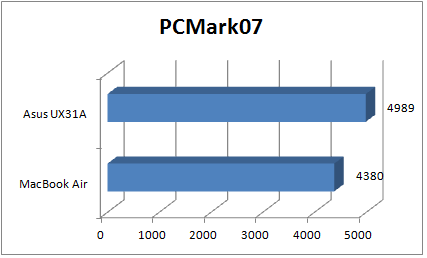
Both notebooks feature Intel’s third-generation Ivy Bridge CPUs. The 2012 Air has a 1.8-GHz Intel Core i5-3427U processor, 4GB of RAM, and 128GB of flash storage. The more expensive UX31A we tested has a more powerful 1.9-GHz Intel Core i7-3517U processor, 4GB of RAM and a 256GB SSD. This difference showed up in the PCMark07 benchmark, where the UX31A notched a score of 4,989 to the Air’s 4,380 (which ran the test in Boot Camp).
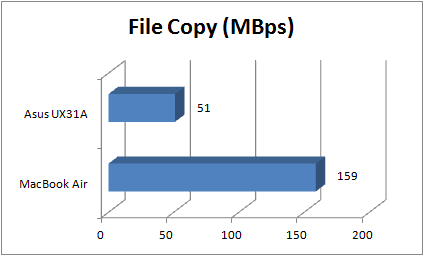
However, the Air’s 128GB flash memory blazed through our file copy test, duplicating 5GB of multimedia at a rate of 159MBps, more than 100MBps faster than the UX31A (51 MBps).
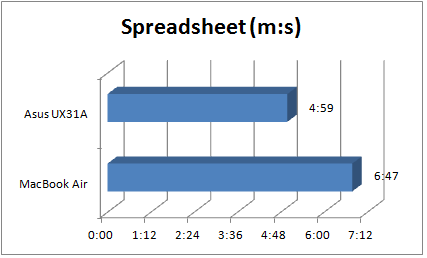
On our Spreadsheet test, which times how long it takes to match 20,000 names with their addresses using OpenOffice, the UX31A took 4 minutes and 59 seconds, much faster than the Air, which took 6:47. For this test, we used OpenOffice in each notebook’s native OS.
WINNER: ASUS UX31A. While the Air has considerably faster Flash memory, the UX31A's more powerful processor delivered better overall performance.
Boot/Wake times
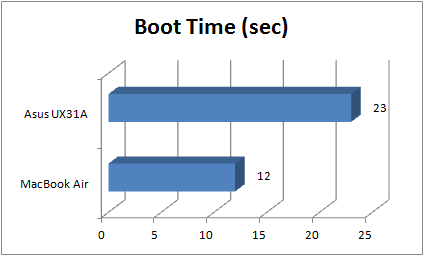
The Air booted in just 12 seconds, five seconds faster than the 2011 version. The UX31A booted in just 23 seconds, which too is fast--the average ultraportable boots in 46 seconds--but it's still nearly twice as long as the Air. However, both machines woke from sleep nearly instantly; the Air took about 2 seconds, and the UX31A took a little less than a second longer.
WINNER: MacBook Air. While both machines were comparable when waking from sleep, it took less time for the Air to boot into its OS than the UX31A.
Graphics
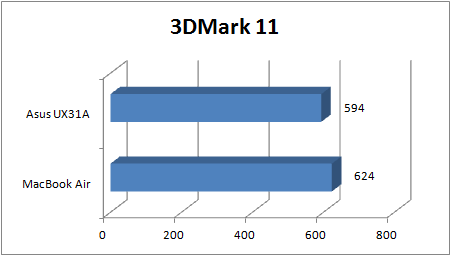
While both machines also have the latest Intel Graphics HD 4000 GPUs, the Air edged out the Asus in most of our tests. On 3DMark11, the Air (Windows 7 running in Boot Camp) scored 624 to the UX31A’s 594. On the Cinebench 11.5 test, the Air scored 17.18 in Mac OS X, compared to the UX31A’s score of 15.52.
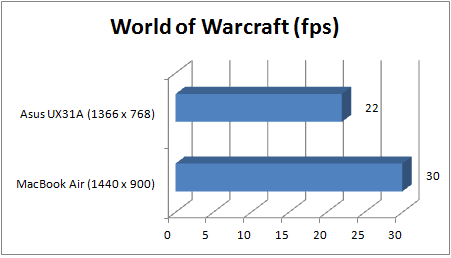
In “World of Warcraft,” which we ran in each notebook’s native OS, the Air averaged 30 frames per second in OS X with the settings on Ultra and the resolution set to 1440 x 900. Using these same graphics settings--but with the screen at 1366 x 768--the UX31A managed just 22 fps.
WINNER: MacBook Air. Since both systems have the same GPU, we’re led to believe that the Mac OS gave the Air the edge in this round.
Battery Life
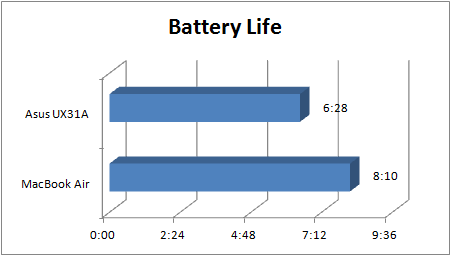
During the LAPTOP Battery Test (Web surfing via Wi-Fi), the Air lasted 8 hours and 10 minutes. That's almost 90 minutes longer than the ultraportable category average, and well above the UX31A, which lasted 6:28.
WINNER: MacBook Air. Apple's ultraportable lasted nearly an hour and a half longer than the UX31A.
Software
Currently, the Air ships with OS X Lion, but in July, it will be updated with Mountain Lion, which offers new features such as Notification Center, deeper iCloud integration with apps such as Messages and documents in the cloud, and the ability to share content via Facebook and Twitter from multiple apps.
The excellent iLife suite (iMovie, iPhoto and GarageBand) is included, as well as FaceTime, Mail and the Mac App Store. The App Store stocks a ton of useful apps and games, which download directly to the iOS-like Launchpad for quick access.
The UX31A comes with the Asus Vibe Fun Center for accessing Music, Games and Books, Instant Connect for taking your notebook online via an Android smartphone and FaceLogon for logging on with facial recognition. However, we were less than thrilled with the incessant pop-ups for McAfee Internet Security and ASUS Webstorage, which provides 2GB of free space for one year.
WINNER: MacBook Air. Not only is its software suite more useful, it’s less annoying, too.
Support & Warranty
The MacBook Air comes with a limited 1-year warranty and an optional 3-year Apple Care warranty. Users can choose to have their computer serviced on the phone or in person at the Apple store Genius Bar. We ranked Apple No. 1 in our Tech Support Showdown and was also tops in our Best & Worst Brand Report.
ASUS covers the Zenbook Prime with a one-year warranty that includes parts, labor, and one instance of accidental coverage as well as 24/7 support. ASUS came in fifth in our our Tech Support Showdown and fifth in our Best & Worst Brands report.
WINNER: MacBook Air. It's hard to beat Apple's customer service.
Price/Value
The Air still commands a premium compared to most laptops, even Ultrabooks, but Apple dropped the starting price on its system. The Air that we used for this head-to-head costs $1,199, and comes with a 1.8-GHz Intel dual-core i5-3427U processor, 4GB of RAM, and 128GB of flash storage. If you spend $400 more, you can get a 2-GHz Core i7 processor and 256GB of flash memory.
By comparison, the UX31A we tested costs $1,499, but has a 1.9-GHz Intel Core i7-3517U processor, 4GB of RAM, a 256GB SSD, and a 1080p display. However, the starting model, which costs $1,149, gets you a 1.7-GHz Intel Core i5-3317U processor, 4GB of RAM, a 128GB SSD, and the 1080p display.
WINNER: ASUS UX31. At the starting price, ASUS offers a higher resolution screen than Apple.
Verdict
Last year, the MacBook Air Air won 7 rounds to 4 for the ASUS, and tied in the remaining two categories. This year, Apple won 7 rounds, Asus won 5, and tied in one category. So ASUS has made progress, and it shows in the improvements the company has made. The UX31A’s keyboard and touchpad are miles better than last year's model, and this machine's 1080p display easily trumps that of the Air. There's a reason why the Zenbook Prime is our Editors' Choice Ultrabook.
Still, Apple's Air offers a faster boot time, better graphics performance, louder speakers and a more reliable touchpad. What tips this battle in the Air's favor is its more than 8 hours of battery life, which allows Apple to repeat as champion in this head-to-head match.
| Row 0 - Cell 0 | Apple MacBook Air | ASUS Zenbook Prime UX31A |
| Design | Row 1 - Cell 1 | X |
| Ports | Row 2 - Cell 1 | X |
| Keyboard | X | X |
| Touchpad | X | Row 4 - Cell 2 |
| Display | Row 5 - Cell 1 | X |
| Speakers | X | Row 6 - Cell 2 |
| Performance | Row 7 - Cell 1 | X |
| Boot/Wake Times | X | Row 8 - Cell 2 |
| Graphics | X | Row 9 - Cell 2 |
| Battery Life | X | Row 10 - Cell 2 |
| Software | X | Row 11 - Cell 2 |
| Support & Warranty | X | Row 12 - Cell 2 |
| Price/Value | Row 13 - Cell 1 | X |
Michael was the Reviews Editor at Laptop Mag. During his tenure at Laptop Mag, Michael reviewed some of the best laptops at the time, including notebooks from brands like Acer, Apple, Dell, Lenovo, and Asus. He wrote in-depth, hands-on guides about laptops that defined the world of tech, but he also stepped outside of the laptop world to talk about phones and wearables. He is now the U.S. Editor-in-Chief at our sister site Tom's Guide, where he oversees all evergreen content and the Homes, Smart Home, and Fitness/Wearables categories for the site..
